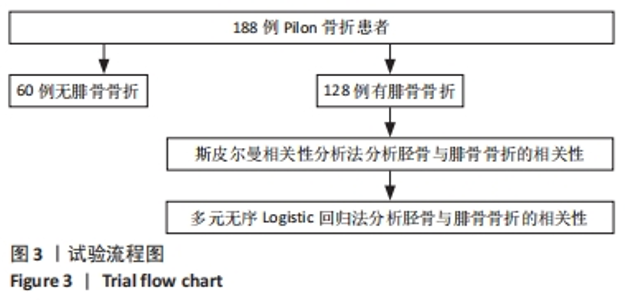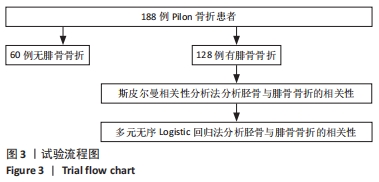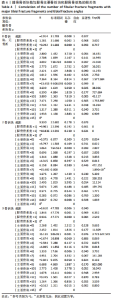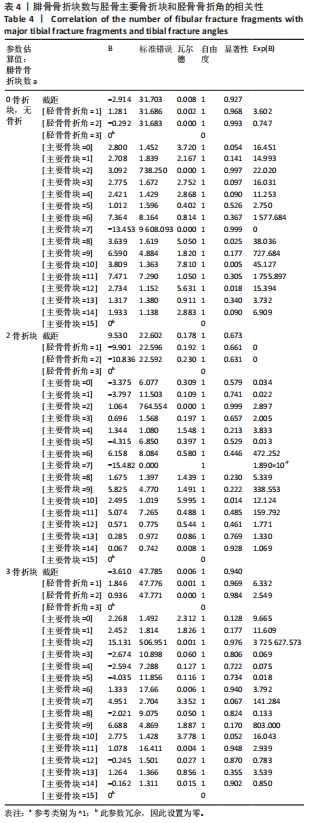Chinese Journal of Tissue Engineering Research ›› 2024, Vol. 28 ›› Issue (21): 3355-3360.doi: 10.12307/2024.084
Previous Articles Next Articles
Correlation of tibial and fibular fractures in Pilon fractures
Xu Shizhuang, Chen Hongquan, Hou Jianwen, Sun Kefu
- The Second People’s Hospital of Lianyungang City, Lianyungang 222000, Jiangsu Province, China
-
Received:2023-04-21Accepted:2023-06-15Online:2024-07-28Published:2023-09-27 -
Contact:Chen Hongquan, The Second People’s Hospital of Lianyungang City, Lianyungang 222000, Jiangsu Province, China -
About author:Xu Shizhuang, Master, Attending physician, The Second People’s Hospital of Lianyungang City, Lianyungang 222000, Jiangsu Province, China
CLC Number:
Cite this article
Xu Shizhuang, Chen Hongquan, Hou Jianwen, Sun Kefu. Correlation of tibial and fibular fractures in Pilon fractures[J]. Chinese Journal of Tissue Engineering Research, 2024, 28(21): 3355-3360.
share this article
Add to citation manager EndNote|Reference Manager|ProCite|BibTeX|RefWorks
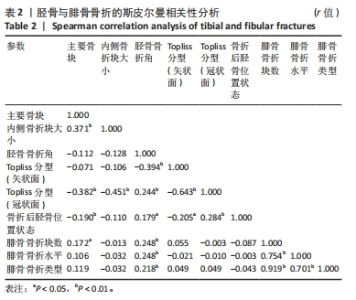
2.3 斯皮尔曼相关性分析 采用斯皮尔曼相关性分析方法分析胫骨位置状态、腓骨骨折水平、腓骨骨折类型、腓骨骨折块数与胫骨骨折胫骨主要骨折块、内侧骨块大小、胫骨骨折角、Topliss分型(矢状面)、Topliss分型(冠状面)的相关性:①骨折后胫骨位置状态与胫骨骨折角和Toplis分型(冠状面)呈弱正相关,与胫骨主要骨折块和Topliss分型(矢状面)呈弱负相关;②胫骨主要骨折块与内侧骨折块大小呈弱正相关,与Topliss分型(冠状面)呈弱负相关;③胫骨骨折角与Topliss分型(冠状面)呈弱正相关,与Topliss分型(矢状面)呈弱负相关;④Topliss分型(冠状面)与Topliss分型(矢状面)呈中负相关;⑤腓骨骨折水平与腓骨骨折类型、腓骨骨折块数呈强正相关,与胫骨骨折角呈弱正相关;⑥腓骨骨折类型与腓骨骨折块数呈强正相关,与胫骨骨折角呈弱正相关;⑦腓骨骨折块数与胫骨主要骨折块、胫骨骨折角呈弱正相关。其余参数之间均P > 0.05,无统计学意义。见表2。"

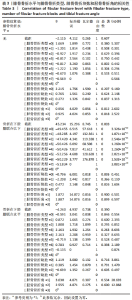
2.4 多元无序Logistic回归分析 再在相关性的基础上采用多元无序Logistic回归分析:①骨折后胫骨位置状态与胫骨主要骨折块、Toplis分型(矢状面)、胫骨骨折角和Toplis分型(冠状面)的相关性;②胫骨主要块与内侧骨折块大小、Toplis分型(冠状面)的相关性;③胫骨骨折角与Toplis分型(矢状面)、Toplis分型(冠状面)的相关性;④Toplis分型(冠状面)与Toplis分型(矢状面)的相关性;⑤腓骨骨折水平与腓骨骨折水平腓骨骨折块数和胫骨骨折角的相关性;⑥腓骨骨折类型与腓骨骨折块数和胫骨骨折角的相关性;⑦腓骨骨折块数与胫骨主要骨折块和胫骨骨折角的相关性。 2.4.1 腓骨骨折水平与骨折类型的相关性 采用多元无序logistic回归分析腓骨骨折水平与腓骨骨折类型、腓骨骨折块数和胫骨骨折角的相关性,结果发现,腓骨骨折水平与腓骨骨折类型具有相关性(P < 0.05)。提示和腓骨撕脱型骨折相比,腓骨横行、斜行、螺旋形、楔形(完整)、楔形(粉碎)、粉碎(完整)、粉碎(多段)更倾向出现在胫腓联合之上。见表3。"

| [1] 王智祥, 魏世隽, 蔡贤华. 胫骨Pilon骨折分型现状[J]. 中国矫形外科杂志,2018,26(6):533-557. [2] HEIM U. Morphological Features for Evaluation and Classification of Pilon Tibial Fractures. Major Fractures of the Pilon, the Talus, and the Calcaneus, 1993. [3] CHEN DW, LI B, AUBEELUCK A, et al. Open reduction and internal fixation of posterior pilon fractures with buttress plate. Acta Ortopedica Brasileira. 2014;22(1):48. [4] ZELLE BA, DANG KH, ORNELL SS. High-energy tibial pilon fractures: an instructional review. Int Orthop. 2019;43(8):1939-1950. [5] SHU W, HU X, YANG X. Comparison Between the Modified External Fixation and Calcaneal Traction in Ruedi-Allgower Type II/III Pilon Fractures. Med Sci Monit. 2021;27:e933385. [6] HADEED MM, EVANS CL, WERNER BC, et al. Does external fixator pin site distance from definitive implant affect infection rate in pilon fractures? Injury. 2019;50(2):503-507. [7] JIANG GQ, JIAO FD, YING WC, et al. [Staged operation for complex closed Pilon fracture] . Zhongguo Gu Shang. 2022;35(9):878-882. [8] KEILER A, RIECHELMANN F, THÖNI M, et al. Three-dimensional computed tomography reconstruction improves the reliability of tibial pilon fracture classification and preoperative surgical planning . Arch Orthop Trauma Surg. 2020;140(2):187-195. [9] LUO T D, PILSON H. Pilon Fracture. StatPearls. Treasure Island (FL); StatPearls Publishing Copyright © 2023, StatPearls Publishing LLC. 2023. [10] BAREI DP, NORK SE, BELLABARBA C, et al. Is the absence of an ipsilateral fibular fracture predictive of increased radiographic tibial pilon fracture severity? J Orthop Trauma. 2006;20(1):6-10. [11] MAUFFREY C, VASARIO G, BATTISTON B, et al. Tibial pilon fractures: a review of incidence, diagnosis, treatment, and complications . Acta Orthop Belg. 2011;77(4):432-440. [12] RUEDI TP, ALLGOWER M. The operative treatment of intra-articular fractures of the lower end of the tibia. Clin Orthop Relat Res. 1979;(138):105-110. [13] LEE YS, CHEN SW, CHEN SH, et al. Stabilisation of the fractured fibula plays an important role in the treatment of pilon fractures: a retrospective comparison of fibular fixation methods. Int Orthop. 2009;33(3):695-699. [14] TORINO D, MEHTA S. Fibular Fixation in Distal Tibia Fractures: Reduction Aid or Nonunion Generator? J Orthop Trauma. 2016;30 Suppl 4:S22-S25. [15] HALLER JM, GITHENS M, ROTHBERG D, et al. Syndesmosis and Syndesmotic Equivalent Injuries in Tibial Plafond Fractures. J Orthop Trauma. 2019;3:e74-e78. [16] BASTIAS C, LAGOS L. New Principles in Pilon Fracture Management: Revisiting Rüedi and Allgöwer Concepts. Foot Ankle Clin. 2020;25(4):505-521. [17] MAIR O, PFLUGER P, HOFFELD K, et al. Management of Pilon Fractures-Current Concepts. Front Surg. 2021;8:764232. [18] TOULOUPAKIS G, MESSORI M, GILLI A, et al.Distal Tibia Fractures: is the Tibia First Technique a Rational Approach? Malays Orthop J. 2023; 1:172-179. [19] EGOL KA, WEISZ R, HIEBERT R, et al. Does fibular plating improve alignment after intramedullary nailing of distal metaphyseal tibia fractures? J Orthop Trauma. 2006;20(2):94-103. [20] BEAR J, ROLLICK N, HELFET D. Evolution in Management of Tibial Pilon Fractures. Curr Rev Musculoskelet Med. 2018;11(4):537-545. [21] PARK YU, KIM SJ, KIM HN. Minimally invasive plate osteosynthesis using the oblong hole of a locking plate for comminuted distal fibular fractures. J Orthop Surg Res. 2021;16(1):281. [22] JUNG GH, CHUNG H, BAEK SH, et al. Percutaneous bridge plating of extra-articular distal fibular fracture for the management of distal tibia type III open fracture. Asian J Surg. 2021;44(1):363-368. [23] KURYLO JC, DATTA N, ISKANDER KN, et al. Does the Fibula Need to be Fixed in Complex Pilon Fractures? J Orthop Trauma. 2015;29(9):424-427. [24] TORINO D, MEHTA S. Fibular Fixation in Distal Tibia Fractures: Reduction Aid or Nonunion Generator? J Orthop Trauma. 2016;4:S22-S25. [25] HOHENBERGER GM, SCHWARZ AM, GRECHENIG C, et al. Dorsal minimally invasive plate osteosynthesis of the distal tibia with regard to adjacent anatomical characteristics. Injury. 2021;5:S11-S16. [26] VIDOVIC D, MATEJCIC A, IVICA M, et al. Minimally-invasive plate osteosynthesis in distal tibial fractures: Results and complications. Injury. 2015;6:S96-S99. [27] HENDRYCH J, PESL T, HAVRANEK P. [Triplane Fractures of the Distal Tibial Epiphysis - Contributions of CT Scans to Indication and Planning of Osteosynthesis. Acta Chir Orthop Traumatol Cech. 2018;85(5):336-342. [28] WANG C, CHEN C, ZHOU Y, et al. Morphological study of CT image of posterior pilon variant fracture and its possible clinical significance. Arch Orthop Trauma Surg. 2023;3:1203-1215. [29] BUSEL GA, WATSON JT, ISRAEL H. Evaluation of Fibular Fracture Type vs Location of Tibial Fixation of Pilon Fractures. Foot Ankle Int. 2017;6:650-655. [30] LUK PC, CHARLTON TP, LEE J, et al. Ipsilateral intact fibula as a predictor of tibial plafond fracture pattern and severity. Foot Ankle Int. 2013;10:1421-1426. [31] KELLAM JF, WADDELL JP. Fractures of the distal tibial metaphysis with intra-articular extension--the distal tibial explosion fracture. J Trauma. 1979;19(8):593-601. [32] TORNETTA P 3RD, GORUP J. Axial computed tomography of pilon fractures. Clin Orthop Relat Res. 1996;323:273-276. [33] 黄彬. 移位Pilon骨折的分型与手术治疗[D]. 武汉:湖北中医药大学, 2010. [34] LABRONICI P, JUNIOR AFM, DA SILVA AAM, et al. CT mapping for complex tibial pilon fractures: Understanding the injury pattern and its relation to the approach choice. Injury. 2021;52 Suppl 3:s70-s76. |
| [1] | Han Bing, Liu Hongbin, Wang Hehong, Zhao Hanqing, Zhao Riguang, Sun Yiyan, Zhang Yu. Correlation between lower limb alignment and risk factors of patellofemoral pain syndrome in young men [J]. Chinese Journal of Tissue Engineering Research, 2024, 28(8): 1211-1216. |
| [2] | Wu Maodong, Su Qinglun, Huang Yiming, Shen Longying, Lu Yu, Zhao Qin. Correlation between coronal pressure variation and coronal imbalance in adolescent idiopathic scoliosis patients [J]. Chinese Journal of Tissue Engineering Research, 2024, 28(6): 852-856. |
| [3] | Wang Mingming, Zhang Zhong, Sun Jianhua, Zhao Gang, Song Hua, Yan Huadong, Lyu Bin. Finite element analysis of three different minimally invasive fixation methods for distal tibial fractures with soft tissue injury [J]. Chinese Journal of Tissue Engineering Research, 2024, 28(6): 879-885. |
| [4] | Zhou Shuliang, Xu Liang, Qian Xuefeng, Zeng Jincai, Zhu Lifan. Correlation between the expression of miRNA-142-3p, mixed lineage kinase 3 and interleukin-1beta in nucleus pulposus and the degree of lumbar intervertebral disc degeneration [J]. Chinese Journal of Tissue Engineering Research, 2024, 28(2): 165-171. |
| [5] | Hou Yiwen, Liu Ying, Li Zhurong, Chen Chen, Li Zhencheng, Liu Yang. Correlation analysis of circular RNAs involved in liver injury in mice with autoimmune hepatitis [J]. Chinese Journal of Tissue Engineering Research, 2024, 28(14): 2152-2158. |
| [6] | Wang Yichang, Lin Wenjie, Lin Tao, Zhou Baian, Huang Wenhua, Liang Zhenming, Wei Jinsong, Ouyang Hanbin. Finite element analysis of three internal fixation methods for distal tibial fractures [J]. Chinese Journal of Tissue Engineering Research, 2023, 27(36): 5760-5765. |
| [7] | Chen Jianchao, Song Huiping. Distribution characteristics of bone mass in different parts of postmenopausal women with knee osteoarthritis [J]. Chinese Journal of Tissue Engineering Research, 2023, 27(31): 5035-5039. |
| [8] | Zhang Jinpeng, Chen Chang, Pan Qiuyu, Mai Chenyao, Li Yinlong, Hao Yuxi, Hu Jun. Correlation between platelet count and lumbar bone mineral density in middle-aged and elderly people [J]. Chinese Journal of Tissue Engineering Research, 2023, 27(31): 5046-5051. |
| [9] | Chen Chao, Geng Fengqin, Shen Suhong. Quantifying the elastic characteristics of the median nerve in healthy subjects: reliability of real-time shear-wave elastography [J]. Chinese Journal of Tissue Engineering Research, 2023, 27(23): 3742-3746. |
| [10] | Li Shichao, Xie Guangyue, Sun Zhen, Han Peng, Hou Xiaohua, Sun Xiaowei, Zhang Qidong. Correlation of knee joint alignment correction between valgus stress and postoperative radiography after unicompartmental knee arthroplasty [J]. Chinese Journal of Tissue Engineering Research, 2023, 27(18): 2910-2914. |
| [11] | Zhang Haolin, Wang Yalin, Liu Yafei, Zuo Yanping, Zhang Xiaohuan. Effect of maxillary protraction on temporomandibular joint changes in skeletal class III children: a correlation analysis [J]. Chinese Journal of Tissue Engineering Research, 2023, 27(11): 1641-1646. |
| [12] | Wu Liang, Wang Qiang, Wang Wenbo, Xin Tianwen, Xi Kun, Tang Jincheng, Xu Jingzhi, Chen Liang, Gu Yong. Risk factors for traumatic central cord syndrome underlying with cervical spondylotic myelopathy [J]. Chinese Journal of Tissue Engineering Research, 2022, 26(9): 1388-1394. |
| [13] | Wang Shuai, Wang Liancheng, Zhang Shuhao, Li Fuli, Dong Jiaxing, Zhang Yajie. Correlation of the electromyography ratio of the paraspinal muscles on the convex and concave sides with Cobb angle, apical vertebra translation, and coronal balance distance in adolescent idiopathic scoliosis patients [J]. Chinese Journal of Tissue Engineering Research, 2022, 26(9): 1402-1406. |
| [14] | Zhang Qiang, Wu Zongde, Liu Liang, Wei Guohua, Peng Liang. Finite element analysis of medial and lateral locking plates for fixation of externally rotated spiral fractures of the lower tibia [J]. Chinese Journal of Tissue Engineering Research, 2022, 26(36): 5750-5754. |
| [15] | Liu Zemin, Lü Xin. Application of intramedullary nailing in the treatment of long tubular bone fractures of the extremities: reaming and non-reaming [J]. Chinese Journal of Tissue Engineering Research, 2022, 26(3): 461-467. |
| Viewed | ||||||
|
Full text |
|
|||||
|
Abstract |
|
|||||
